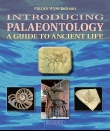Sökning: onr:12418909 > Introducing palaeon...
- 1 av 1
- Föregående post
- Nästa post
- Till träfflistan
Introducing palaeontology : a guide to ancient life / Patrick N. Wyse Jackson ; with illustrations by John Murray.
- Wyse Jackson, Patrick. (författare)
- ISBN 9781906716158
- Publicerad: Edinburgh : Dunedin, c2010.
- Engelska viii, 152 p.
- Bok
Innehållsförteckning
Sammanfattning
Ämnesord
Inställningar
Hjälp
Stäng
- The Science of Fossils. The fascination of fossils -- A chancy business: the preservation of fossils -- From the field to the laboratory: how to collect, curate and study fossils -- Code of conduct for fossil collectors -- Taxonomy: how to classify and identify fossils -- Uses of fossils -- Fossil Lagerstatten: exceptional preservation of fossils -- Early ideas on the nature and significance of fossils -- Fossil Groups. Algae and vascular plants -- Unicellular animals: Foraminifera and radiolarians -- Sponges -- Cnidaria -- Bryozoans -- Molluscs -- Brachiopoda -- Echinodermata -- Arthropods -- Graptolites -- Conodonts -- Fishes -- Tetrapods and amphibians -- Reptiles -- Birds -- Mammals -- Hominids and hominins -- Trace fossils.
- Life on Earth can be traced back over three thousand million years into the past. Many examples of the Earth's past inhabitants are to be found in rocks, preserved as beautiful and fascinating fossils. The earliest life forms were bacteria and algae; these produced the oxygen that enabled more complex life forms to develop. About 600 million years ago multi-cellular organisms appeared on Earth, some of which could protect themselves with hard parts such as shells. Many of these life forms were readily fossilized and are used to subdivide geological time. Numerous species have evolved and most are now extinct. Lineages can be traced and extinctions explained as a consequence of terrestrial and extra-terrestrial events. Illustrated with photographs and explanatory diagrams this text provides an introduction to the science of palaeontology. The book is divided into two parts. The first explains what a fossil is; how fossils came to be preserved; how they are classified; and what information they can tell scientists about the rocks in which they are found. The second part introduces the major fossil groups taking a systematic view from algae and plants, through the numerous examples of invertebrate animals, to the vertebrates and finally to man's ancestors.
Ämnesord
- Paleontologi (sao)
- Paleontology. (LCSH)
- Paleontology (LCSH)
Klassifikation
- QE711.3 (LCC)
- 560 (DDC)
- Udb (kssb/8 (machine generated))
Titeln finns på 1 bibliotek.
Bibliotek i Mellansverige (1)
Ange som favorit- Uppsala universitetsbibliotek, Geo-biblioteket (Ugg)Ange som favorit
- Mina lånLåna/reservera
-
- Placering: 560 Wyse
- 1 av 1
- Föregående post
- Nästa post
- Till träfflistan
Sök vidare
Hjälp
- Fler titlar av
- Wyse Jackson, Patric ...
- Fler titlar om
- Paleontologi
- Paleontology.
- Paleontology
Sök utanför LIBRIS
Hjälp
- Sök vidare i:
- Google Book Search
- Google Scholar
- LibraryThing
Kungliga biblioteket hanterar dina personuppgifter i enlighet med EU:s dataskyddsförordning (2018), GDPR. Läs mer om hur det funkar här.
Så här hanterar KB dina uppgifter vid användning av denna tjänst.
Copyright © LIBRIS - Nationella bibliotekssystem

